
Orchids are plants that belong to the family Orchidaceae, a diverse and widespread group of flowering plants with blooms that are often colourful and fragrant.

Vanda, abbreviated in the horticultural trade as V., is a genus in the orchid family, Orchidaceae. There are about 87 species, and the genus is commonly cultivated for the marketplace. This genus and its allies are considered to be among the most specifically adapted of all orchids within the Orchidaceae. The genus is highly prized in horticulture for its showy, fragrant, long-lasting, and intensely colorful flowers. Vanda species are widespread across East Asia, Southeast Asia, and New Guinea, with a few species extending into Queensland and some of the islands of the western Pacific.

William Henry Forester Denison, 1st Earl of Londesborough, known as The Lord Londesborough from 1860 to 1887, was a British peer and Liberal politician. He was also one of the main founders of Scarborough FC.
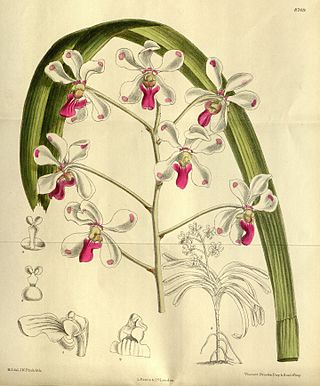
Vanda luzonica is a species of vanda, a flower of the orchid family. It is a rare type of orchid and is endangered. Vanda luzonica is named after the island of Luzon in the Philippines.
Henryi, a new Latin adjective used for any of several naturalists named Henry, may refer to:
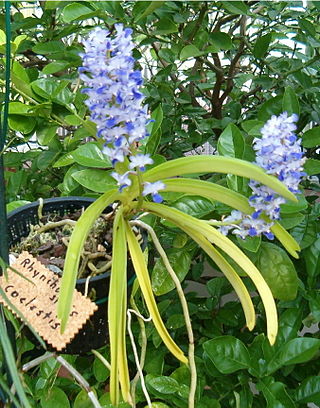
Rhynchostylis is a genus in the orchid family (Orchidaceae), closely allied to the genus Vanda and comprising four currently accepted species native to the Indian Subcontinent, China, Indochina, Malaysia, Indonesia and the Philippines. The name consists of a compound of two Greek elements : rhynchos 'beak' and stylis 'column' – in reference to the very broad, fleshy column of the flower. The flowers are borne in dense racemes and are noted for their intense, spicy fragrance. Although lacking in pseudobulbs, the plants have leathery leaves that are drought-resistant. These orchids grow naturally in warm, moist, shaded tropical areas and will thrive in cultivation if given consistent warmth, uniform moisture and bright, but indirect light. Hobbyists wanting to grow them will need a warm, humid growing environment with gentle air movement. They can be grown in pots, but are better grown in baskets, owing to the extreme fleshiness of their roots. Their unusually fragrant blooms often appear in the slightly cooler winter months.
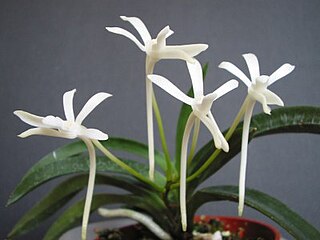
Neofinetia was a genus of flowering plants from the orchid family, Orchidaceae, that is now classified as a Vanda. It contained three species and was distributed in China, Korea, and Japan.
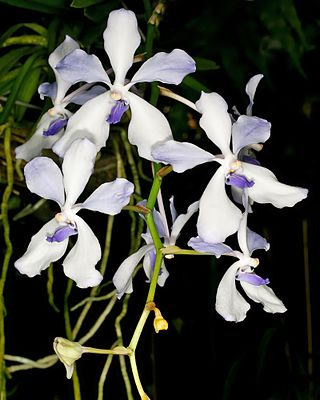
Vanda coerulea, commonly known as blue orchid, blue vanda or autumn lady's tresses, is a species of orchid found in Northeast India with its range extending to China. It is known as kwaklei in Manipuri and vandaar in Sanskrit. It has bluish purple flowers which are very long-lasting compared to other orchids. The plant bears up to 20 to 30 spikes.

Vanda coerulescens, also known as sky-blue vanda, is a species of monopodial orchid native to Assam and Arunachal Pradesh, India, eastern Himalayas, southern Yunnan province in China, Myanmar and Thailand.

Vanda cristata is a species of orchid found growing in the Himalaya from Bangladesh, India, Nepal, Bhutan to China at elevations of 600 – 2300 meters.

Vanda tessellata is a species of orchid occurring from the Indian subcontinent to Indochina. It is a medicinal plant.
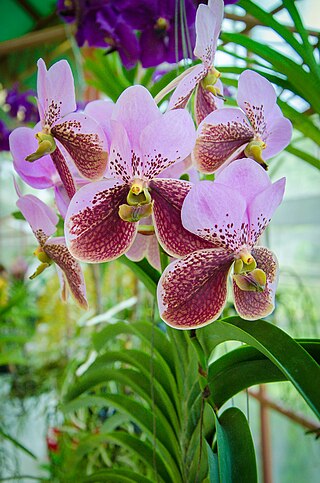
Vanda sanderiana is a species of orchid. It is commonly called Waling-waling in the Philippines and is also called Sander's Vanda, after Henry Frederick Conrad Sander, a noted orchidologist. The orchid is considered to be the "Queen of Philippine flowers" and is worshiped as a diwata by the indigenous Bagobo people.

Papilionanthe Miss Joaquim, also known as the Singapore orchid, the Princess Aloha orchid and formerly as Vanda Miss Joaquim, is a hybrid orchid that is the national flower of Singapore. For its resilience and year-round blooming quality, it was chosen on 15 April 1981 to represent Singapore's uniqueness and hybrid culture.

Vanda falcata, also known as 风兰 in Chinese, 풍란 (pungnan) in Korean, 風蘭 (fūran) in Japanese, or the wind orchid in English, is a species of orchid found in China, Korea, and Japan. It was formerly classified in the genus Neofinetia.
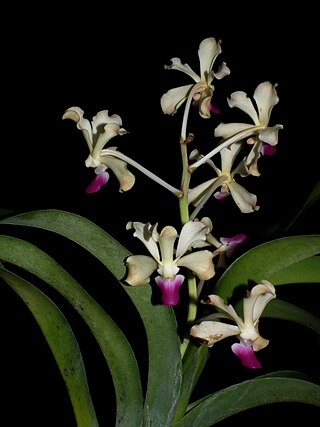
Vanda ustii, the University of Santo Tomas' vanda, is an orchid species found only in the Philippines. It is named after the University of Santo Tomas or U.S.T.

Ashkhen Hovakimian was a Singaporean Armenian who bred Singapore's first hybridised orchid hybrid, Vanda 'Miss Joaquim'. Joaquim was inducted into the Singapore Women's Hall of Fame in 2015.

Vanda roeblingiana, Roebelen's vanda, is a species of orchid endemic to the mountain provinces of the island of Luzon in the Philippines. Hugh Low, a British colonial administrator and naturalist introduced the plant to London in 1893. The next year, Robert Allen Rolfe, an English botanist formally described the plant and thought it was originally collected from the vicinity of Singapore or Peninsular Malaysia. Low, who works in Clapton Nursery had collecting expedition to Southeast Asia with Singapore as headquarter.
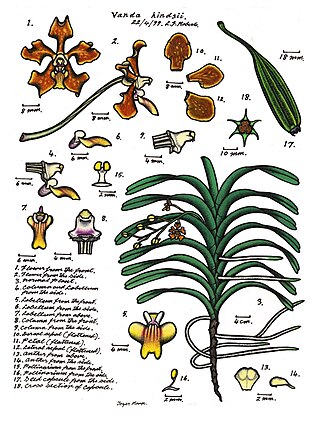
Vanda hindsii, commonly known as the native strap orchid or the Cape York vanda, is a large epiphytic or lithophytic clump-forming orchid. It has thick, white, cord-like roots, branching stems, many thick, leathery, strap-like leaves and between three and seven shiny brown flowers with greenish to yellow markings and a white labellum. This orchid occurs in New Guinea and tropical North Queensland.

Vanda ampullacea is a perennial epiphytic orchid found in southeast Asia from Nepal to China and India, including the eastern Himalayas. It has had various classifications, initially called Aerides ampullacea by William Roxburgh when it was first described in 1814. It was most recently reclassified in 2012 during a taxonomic revision of Vanda. In 1868, one if its cultivars received a First Class Certificate from the Royal Horticultural Society.
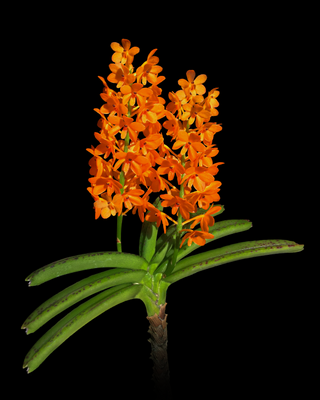
Vanda garayi, or Garay's ascocentrum, is a small monopodial epiphytic orchid native to semi-deciduous and deciduous dry lowland forests of Thailand, Laos, and Sumatra.



















